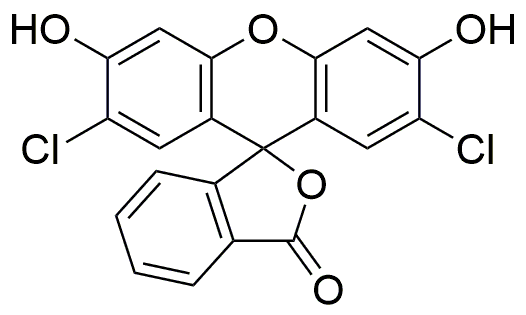2',7'-Dichlorofluorescein is widely utilized in research focused on:
- Biological Imaging: This compound serves as a fluorescent dye, enabling researchers to visualize cellular processes in live cells under a fluorescence microscope, enhancing studies in cell biology and microbiology.
- Environmental Monitoring: It is used as a tracer in water studies to track the movement of pollutants, helping environmental scientists assess contamination levels and the effectiveness of remediation efforts.
- Diagnostic Applications: In medical diagnostics, it aids in the detection of certain diseases by highlighting specific tissues or cells, providing valuable information for accurate diagnosis.
- Fluorescent Probes: The compound acts as a probe in various chemical assays, allowing for the detection of specific ions or molecules, which is crucial in analytical chemistry and quality control in pharmaceuticals.
- Research in Photodynamic Therapy: Its properties are explored in cancer research, where it may be used to develop treatments that harness light to activate therapeutic agents, offering a targeted approach to cancer treatment.
General Information
Properties
Safety and Regulations
Applications
2',7'-Dichlorofluorescein is widely utilized in research focused on:
- Biological Imaging: This compound serves as a fluorescent dye, enabling researchers to visualize cellular processes in live cells under a fluorescence microscope, enhancing studies in cell biology and microbiology.
- Environmental Monitoring: It is used as a tracer in water studies to track the movement of pollutants, helping environmental scientists assess contamination levels and the effectiveness of remediation efforts.
- Diagnostic Applications: In medical diagnostics, it aids in the detection of certain diseases by highlighting specific tissues or cells, providing valuable information for accurate diagnosis.
- Fluorescent Probes: The compound acts as a probe in various chemical assays, allowing for the detection of specific ions or molecules, which is crucial in analytical chemistry and quality control in pharmaceuticals.
- Research in Photodynamic Therapy: Its properties are explored in cancer research, where it may be used to develop treatments that harness light to activate therapeutic agents, offering a targeted approach to cancer treatment.
Documents
Safety Data Sheets (SDS)
The SDS provides comprehensive safety information on handling, storage, and disposal of the product.
Product Specification (PS)
The PS provides a comprehensive breakdown of the product’s properties, including chemical composition, physical state, purity, and storage requirements. It also details acceptable quality ranges and the product's intended applications.
Certificates of Analysis (COA)
Search for Certificates of Analysis (COA) by entering the products Lot Number. Lot and Batch Numbers can be found on a product’s label following the words ‘Lot’ or ‘Batch’.
*Catalog Number
*Lot Number
Certificates Of Origin (COO)
This COO confirms the country where the product was manufactured, and also details the materials and components used in it and whether it is derived from natural, synthetic, or other specific sources. This certificate may be required for customs, trade, and regulatory compliance.
*Catalog Number
*Lot Number
Safety Data Sheets (SDS)
The SDS provides comprehensive safety information on handling, storage, and disposal of the product.
DownloadProduct Specification (PS)
The PS provides a comprehensive breakdown of the product’s properties, including chemical composition, physical state, purity, and storage requirements. It also details acceptable quality ranges and the product's intended applications.
DownloadCertificates of Analysis (COA)
Search for Certificates of Analysis (COA) by entering the products Lot Number. Lot and Batch Numbers can be found on a product’s label following the words ‘Lot’ or ‘Batch’.
*Catalog Number
*Lot Number
Certificates Of Origin (COO)
This COO confirms the country where the product was manufactured, and also details the materials and components used in it and whether it is derived from natural, synthetic, or other specific sources. This certificate may be required for customs, trade, and regulatory compliance.


